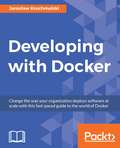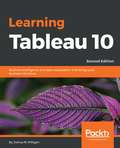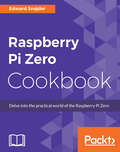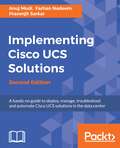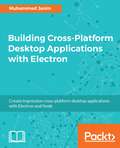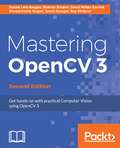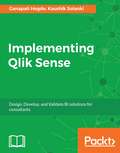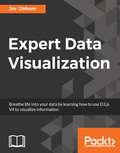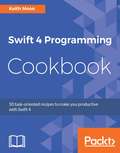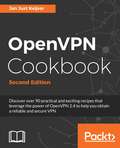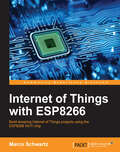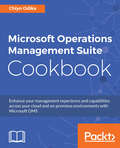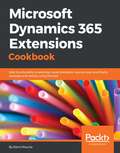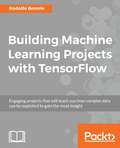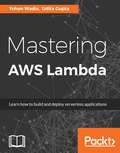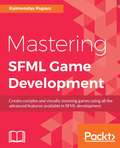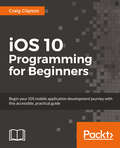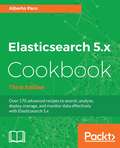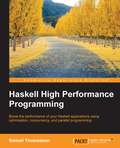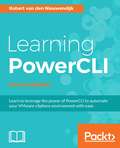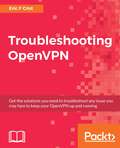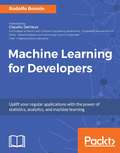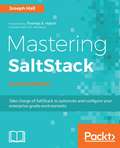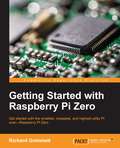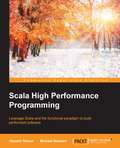- Table View
- List View
Developing with Docker
by Jaroslaw KrochmalskiAbout This BookCut through the noise and in simple terms learn to package your applications and test, ship, and scale your containersFind and build images and successfully run your programs within containersBuild, deploy, and test your Docker containers and put them to work in productionWho This Book Is ForThis book is for IT professionals, system administrators, and DevOps professionals or anyone looking to quickly develop and deploy software to production at scale. If you are interested in Docker, DevOps, or containers in general, don't look any further.What You Will LearnUnderstand the concepts and architecture behind DockerInstall Docker on various platforms and explore tools such as Docker CLI or KinematicBuild, ship, and run distributed applicationsDeploy, automate, and manage the execution of applications within DockerScale and virtualize images and containersUtilize the networking and storage features that Docker offersLearn to run programs within containers and get to grips with the container lifecycle and cleanup processUse repositories to store and retrieve imagesIn DetailThis fast-paced and practical guide will get you up and running with Docker. Using Docker, you will be able to build, ship, and run many distributed applications in real time.Starting with an introduction to Docker, this book will cover precise and practical instructions to install Docker Toolbox on Mac, Linux, Windows, and Cloud. You will gain a deeper insight into the concepts and architecture of Docker. The book will cover different types of containers and their applications and show you how to find and build images. Next, you will learn about container networking the different types of Docker volumes. You will learn how to contribute to the image repository by publishing different images. This will familiarize you with the image building process and you will also be able to successfully run your programs within containers.By the end of this book, you will be well equipped in deploying your applications using Docker and will have a clear understanding of concepts, techniques, and practical methods to get it running in production systems.
Learning Tableau 10 Second Edition
by Joshua N. Milligan<P><P>Learn how to create effective data visualizations with Tableau and unlock a smarter approach to business analytics. It might just transform your organization <P><P>About This Book <P><P>Create stylish visualizations and dashboards that explain complexity with clarity <P><P>Learn effective data storytelling to transform how your business uses ideas and makes decisions <P><P>Explore all the new features in Tableau 10 and start to redefine what business analytics means to your organization <P><P>Who This Book Is For <P><P>Got data? Not sure what to make of it? This is the guide for you - whether you've been working with Tableau for years or are just beginning your adventure into business analytics. <P><P>What You Will Learn <P><P>Find out how to build effective visualizations and dashboards <P><P>Prepare and clean your data so you can be sure Tableau is finding answers to your questions - not raising more problems <P><P>Discover how to create advanced visualizations that explain complexity with clarity and style <P><P>Dig deeper into your data with clustering and distribution models that allow you to analyze trends and make forecasts <P><P>Learn how to use data storytelling to aid decision-making and strategy <P><P>Share dashboards and visualizations to cultivate a culture where data is available and valued <P><P>In Detail <P><P>Tableau has for some time been one of the most popular Business Intelligence and data visualization tools available. Why? Because, quite simply, it's a tool that's responsive to the needs of modern businesses. But it's most effective when you know how to get what you want from it - it might make your business intelligent, but it isn't going to make you intelligent. <P><P>We'll make sure you're well prepared to take full advantage of Tableau 10's new features. Whether you're an experienced data analyst that wants to explore 2016's new Tableau, or you're a beginner that wants to expand their skillset and bring a more professional and sharper approach to their organization, we've got you covered. Beginning with the fundamentals, such as data preparation, you'll soon learn how to build and customize your own data visualizations and dashboards, essential for high-level visibility and effective data storytelling. You'll also find out how to so trend analysis and forecasting using clustering and distribution models to inform your analytics. <P><P>But it's not just about you - when it comes to data it's all about availability and access. That's why we'll show you how to share your Tableau visualizations. It's only once insights are shared and communicated that you - and your organization - will start making smarter and informed decisions. And really, that's exactly what this guide is for.
Raspberry Pi Zero Cookbook
by Edward SnajderOver 80 practical and interesting recipes that explore the plethora of functionalities and opportunities available with Raspberry Pi Zero About This Book • Deep dive into the components of the small yet powerful Raspberry Pi Zero • Get into grips with integrating various hardware, programming, and networking concepts with the so-called “cheapest computer” • Explore the functionalities of this $5 chip through practical recipes Who This Book Is For This book is for programmers and hobbyists who are eager to dive deep into the Raspberry Pi Zero. If you have basic or zero knowledge of the Raspberry Pi Zero, or if you looking for examples of ways to utilize the Raspberry Pi's GPIO interface, then this book is ideal for you. Basic knowledge of Python will be beneficial, and experience with circuitry and electronics will be needed for the later chapters in the book. What You Will Learn • Set up your Raspberry Pi Zero with the operating system, networking, and different interfaces • Get a hands-on introduction to Linux, Python, and shell scripts with the Raspberry Pi Zero • Become a master at driving GPIOs and controlling relays, motors, transistors, buzzers, audio, read switches, and interrupts with the Raspberry Pi Zero • Control GPIOs using the web interface and Node.js • Connect displays, LED matrixes, analog sensors, and digital sensors • Hack the Ethernet on the Raspberry Pi Zero • Make your Raspberry Pi Zero an IoT-based sensor node and remotely monitor your data In Detail The Raspberry Pi Zero, one of the most inexpensive, fully-functional computers available, is a powerful and revolutionary product developed by the Raspberry Pi Foundation. The Raspberry Pi Zero opens up a new world for the makers out there. This book will give you expertise with the Raspberry Pi Zero, providing all the necessary recipes that will get you up and running. In this book, you will learn how to prepare your own circuits rather than buying the expensive add–ons available in the market. We start by showing you how to set up and manage the Pi Zero and then move on to configuring the hardware, running it with Linux, and programming it with Python scripts. Later, we integrate the Raspberry Pi Zero with sensors, motors, and other hardware. You will also get hands-on with interesting projects in media centers, IoT, and more. Style and approach This recipe-based book will ensure you gain an intermediate-level knowledge of the Raspberry Pi Zero. This book contains comprehensive illustrations with specific schematics for each circuit diagram.
Implementing CISCO UCS Solutions - Second Edition
by Anuj ModiThis book is for system, network, and storage administrators who are responsible for Cisco UCS deployments. You need to have basic knowledge of server architecture, network, and storage technologies.
Building Cross-Platform Desktop Applications with Electron
by Muhammed JasimLearn how to develop cross-platform desktop app from scratch with Electron and Node About This Book • Build a solid foundation with Electron for an easier development experience • Use modern JavaScript frameworks and tools along with Electron to take your desktop applications to the next level • Extend the functionality of Electron through modules Who This Book Is For If you are a developer with prior experience of building front-end applications and you are keen on developing a cross-platform desktop application, then this book is for you. This book is also ideal for experienced JavaScript developers with a basic understanding of front-end development and Node.js development. What You Will Learn • Explore various tools and libraries to build and debug an Electron application • Use popular JavaScript frameworks such as Angular and Typescript along with Electron to enhance your app • Work with the desktop UI development for Electron using Photon • Find out how to use various Electron APIs like Clipboard, Process, Shell, Image, File, Session, and Cookie • Integrate your application into different desktop environments with Electron API • Cache your network resources using service worker • Test the Electron application using Mocha and Spectron • See how to package and distribute an Electron application In Detail Though web applications are becoming increasingly popular, desktop apps are still important. The Electron framework lets you write cross-platform desktop applications using JavaScript, HTML, and CSS, and this book will teach you how to create your first desktop application with Electron. It will guide you on how to build desktop applications that run on Windows, Mac, and Linux platforms. You will begin your journey with an overview of Electron, and then move on to explore the various stages of creating a simple social media application. Along the way, you will learn how to use advanced Electron APIs, debug an Electron application, and make performance improvements using the Chrome developer tools. You'll also find out how to package and distribute an application, and more. By the end of the book, you will be able to build a complete desktop application using Electron and web technologies. You will have a solid understanding of the common challenges that desktop app developers face, and you'll know how to solve them. Style and approach Covers everything you need to know about Electron with full examples and explanations to get you building desktop apps with Electron as quickly as possible.
Mastering OpenCV 3 - Second Edition
by Shervin Emami Daniel Lélis BaggioThis book is for those who have a basic knowledge of OpenCV and are competent C++ programmers. You need to have an understanding of some of the more theoretical/mathematical concepts, as we move quite quickly throughout the book.
Implementing Qlik Sense
by Ganapati Hegde Kaushik SolankiBecome a full-fledged Qlik Sense Consultant with the help of this unique guide About This Book • Become a successful Qlik consultant with the help of this insightful guide • Build what is in line as well as exceeding your customer's expectations from your Qlik Sense solutions using this highly practical guide • Build result-driven optimized BI solutions using Qlik with the help of industry examples Who This Book Is For If you have basic familiarity with Qlik Sense and want to upgrade your skills to become a full-fledged Qlik Consultant, this book is for you. With this book, you will be able to create efficient business intelligence solutions that would fetch client satisfaction, and in turn, more projects. What You Will Learn • Understand the importance and expectations of a consultant's role • Engage with the customer to understand the ir goals and future objectives • Design the optimum architecture, using the best practices for the development and implementation of your projects • Ensure successful adoption using real-life examples to make your learning complete • Learn about the important stages of a Qlik project's life cycle In Detail Qlik Sense is a leading platform for business intelligence (BI) solutions. Qlik Sense helps organizations in making informed decisions based on the data they have. This book will teach you how to effectively use Qlik for optimum customer satisfaction. You will undergo a metamorphosis from a developer to a consultant who is capable of building the most suitable BI solutions for your clients. The book will take you through several business cases – this will give you enough insight to understand the needs of the client clearly and build a BI solution that meets or exceeds their expectations. Starting from the pre-project activities, you will go to the actual execution of the project, the implementation, and even maintenance. This book will give you all the information you need - from the strategy to requirement gathering to implementing BI solutions using Qlik Sense. The book will empower you to take the right decisions in tricky and diffi cult situations while developing analytics and dashboards. Style and approach This book will be a hands-on guide that will teach you all the what-to-do's, when-to-do's, and how-to-do's for becoming a successful Qlik Sense Consultant. With the help of various business scenarios, the book will cover real-world problems that you can relate to. Various solutions in the book will be backed up by the thought process of why are these solutions used and how you can implement them in your own business environment.
Expert Data Visualization
by Jos DirksenBreathe life into your data by learning how to use D3.js V4 to visualize information About This Book • Create complex visualizations powered by D3.js and open data. • Provides an extensive set of visualizations that explore all the functionality provided by D3.js V4. • Shows how to set up an easy–to-use environment to create stunning visualizations. Who This Book Is For The typical target audience of this book is JavaScript developers, designers, and visual artists who have some basic JavaScript programming knowledge and who now want to master pro-level techniques to create interactive data visualizations using web standards which work on desktop as well as mobile devices. What You Will Learn • Learn how D3.js works to declaratively define visualizations. • Create charts from scratch by using SVG and the D3.js APIs • See how to prepare data for easy visualization using D3.js. • Visualize hierarchical data using chart types provided by D3.js • Explore the different options provided by D3.js to visualize linked data such as graphs. • Spice up your visualizations by adding interactivity and animations. • Learn how to use D3.js to visualize and interact with Geo- and Gis-related information sources. • Create visualization by streaming data over WebSockets In Detail Do you want to make sense of your data? Do you want to create interactive charts, data trees, info-graphics, geospatial charts, and maps efficiently? This book is your ideal choice to master interactive data visualization with D3.js V4. The book includes a number of extensive examples that to help you hone your skills with data visualization. Throughout nine chapters these examples will help you acquire a clear practical understanding of the various techniques, tools and functionality provided by D3.js. You will first setup your D3.JS development environment and learn the basic patterns needed to visualize your data. After that you will learn techniques to optimize different processes such as working with selections; animating data transitions; creating graps and charts, integrating external resources (static as well as streaming); visualizing information on maps; working with colors and scales; utilizing the different D3.js APIs; and much more. The book will also guide you through creating custom graphs and visualizations, and show you how to go from the raw data to beautiful visualizations. The extensive examples will include working with complex and realtime data streams, such as seismic data, geospatial data, scientific data, and more. Towards the end of the book, you will learn to add more functionality on top of D3.js by using it with other external libraries and integrating it with Ecmascript 6 and Typescript Style and approach This book will have a real–world, case-study approach, where you will be given data sets from different domains. These data sets will have different visualization goals; some might need 2D or 3D charts, some might need automated workflows, others might require interactive maps. While you fulfill these goals, you will learn different techniques and best practices, which will enable you to perform data visualization tasks on your own
Swift 4 Programming Cookbook
by Keith MoonOver 50 recipes to help you quickly and efficiently build applications with Swift 4 and Xcode 9 About This Book • Write robust and efficient code and avoid common pitfalls using Swift 4 • Get a comprehensive coverage of the tools and techniques needed to create multi-platform apps with Swift 4 • Packed with easy-to-follow recipes, this book will help you develop code using the latest version of Swift Who This Book Is For If you are looking for a book to help you learn about the diverse features offered by Swift 4 along with tips and tricks to efficiently code and build applications, then this book is for you. Basic knowledge of Swift or general programming concepts will be beneficial. What You Will Learn • Explore basic to advanced concepts in Swift 4 Programming • Unleash advanced features of Apple's Xcode 9 IDE and Swift Playgrounds • Learn about the conditional statements, loops, and how to handle errors in Swift • Define flexible classes and structs using Generics, and learn about the advanced operators, and create custom operators • Explore functionalities outside of the standard libraries of Swift • Import your own custom functionality into Swift Playgrounds • Run Swift on Linux and investigate server-side programming with the server side framework Vapor In Detail Swift 4 is an exciting, multi-platform, general-purpose programming language. Being open source, modern and easy to use has made Swift one of the fastest growing programming languages. If you interested in exploring it, then this book is what you need. The book begins with an introduction to the basic building blocks of Swift 4, its syntax and the functionalities of Swift constructs. Then, introduces you to Apple's Xcode 9 IDE and Swift Playgrounds, which provide an ideal platform to write, execute, and debug the codes thus initiating your development process. Next, you'll learn to bundle variables into tuples, set order to your data with an array, store key-value pairs with dictionaries and you'll learn how to use the property observers. Later, explore the decision-making and control structures in Swift and learn how to handle errors in Swift 4. Then you'll, examine the advanced features of Swift, generics and operators, and then explore the functionalities outside of the standard library, provided by frameworks such as Foundation and UIKit. Also, you'll explore advanced features of Swift Playgrounds. At the end of the book, you'll learn server-side programming aspect of Swift 4 and see how to run Swift on Linux and then investigate Vapor, one of the most popular server-side frameworks for Swift. Style and approach Each recipe addresses a specific problem, with a detailed discussion that explains the solution and offers insight into how it works.
OpenVPN Cookbook - Second Edition
by Jan Just KeijserDiscover over 90 practical and exciting recipes that leverage the power of OpenVPN 2.4 to help you obtain a reliable and secure VPN About This Book • Master the skills of configuring, managing, and securing your VPN using the latest OpenVPN • Gain expertise in establishing IPv6 connections and understand PolarSSL using the latest version of OpenVPN • This book contains enticing recipes about OpenVPN functionalities that cater to mission critical applications Who This Book Is For This book is for system administrators who have a basic knowledge of OpenVPN and are eagerly waiting to build, secure, and manage VPNs using the latest version. This book assumes some prior knowledge of TCP/IP networking and OpenVPN and you must have network administration skills to get the most out of this book. What You Will Learn • Determine the best type of OpenVPN setup for your networking needs • Get to grips with the encryption, authentication, and certifications features of OpenSSL. • Integrate an OpenVPN server into the local IT infrastructure with the scripting features of OpenVPN • Ease the integration of Windows clients into the VPN using Windows-specific client-side configuration • Understand the authentication plugins for PAM and LDAP • Get to know the difference between TUN-style and TAP-style networks and when to use what • Troubleshoot your VPN setup • Establish a connection via IPv6 along with demonstrations In Detail OpenVPN provides an extensible VPN framework that has been designed to ease site-specific customization, such as providing the capability to distribute a customized installation package to clients, and supporting alternative authentication methods via OpenVPN's plugin module interface. This book provides you with many different recipes to help you set up, monitor, and troubleshoot an OpenVPN network. You will learn to configure a scalable, load-balanced VPN server farm that can handle thousands of dynamic connections from incoming VPN clients. You will also get to grips with the encryption, authentication, security, extensibility, and certifications features of OpenSSL. You will also get an understanding of IPv6 support and will get a demonstration of how to establish a connection via IPv64. This book will explore all the advanced features of OpenVPN and even some undocumented options, covering all the common network setups such as point-to-point networks and multi-client TUN-style and TAP-style networks. Finally, you will learn to manage, secure, and troubleshoot your virtual private networks using OpenVPN 2.4. Style and approach This practical, recipe-based book covers the core functionalities of OpenVPN ending with troubleshooting, performance tuning and making the readers inquisitive about the advanced features.
Internet of Things with ESP8266
by Marco SchwartzBuild amazing Internet of Things projects using the ESP8266 Wi-Fi chip About This Book • Get to know the powerful and low cost ESP8266 and build interesting projects in the field of Internet of Things • Configure your ESP8266 to the cloud and explore the networkable modules that will be utilized in the IoT projects • This step-by-step guide teaches you the basics of IoT with ESP8266 and makes your life easier Who This Book Is For This book is for those who want to build powerful and inexpensive IoT projects using the ESP8266 WiFi chip, including those who are new to IoT, or those who already have experience with other platforms such as Arduino. What You Will Learn • Control various devices from the cloud • Interact with web services, such as Twitter or Facebook • Make two ESP8266 boards communicate with each other via the cloud • Send notifications to users of the ESP8266, via email, text message, or push notifications • Build a physical device that indicates the current price of Bitcoin • Build a simple home automation system that can be controlled from the cloud • Create your own cloud platform to control ESP8266 devices In Detail The Internet of Things (IoT) is the network of objects such as physical things embedded with electronics, software, sensors, and connectivity, enabling data exchange. ESP8266 is a low cost WiFi microcontroller chip that has the ability to empower IoT and helps the exchange of information among various connected objects. ESP8266 consists of networkable microcontroller modules, and with this low cost chip, IoT is booming. This book will help deepen your knowledge of the ESP8266 WiFi chip platform and get you building exciting projects. Kick-starting with an introduction to the ESP8266 chip, we will demonstrate how to build a simple LED using the ESP8266. You will then learn how to read, send, and monitor data from the cloud. Next, you'll see how to control your devices remotely from anywhere in the world. Furthermore, you'll get to know how to use the ESP8266 to interact with web services such as Twitter and Facebook. In order to make several ESP8266s interact and exchange data without the need for human intervention, you will be introduced to the concept of machine-to-machine communication. The latter part of the book focuses more on projects, including a door lock controlled from the cloud, building a physical Bitcoin ticker, and doing wireless gardening. You'll learn how to build a cloud-based ESP8266 home automation system and a cloud-controlled ESP8266 robot. Finally, you'll discover how to build your own cloud platform to control ESP8266 devices. With this book, you will be able to create and program Internet of Things projects using the ESP8266 WiFi chip. Style and approach This is a step-by-step guide that provides great IOT projects with ESP8266. All the key concepts are explained details with the help of examples and demonstrations of the projects.
Microsoft Operations Management Suite Cookbook: Enhance your management experience and capabilities across your cloud and on-premises environments with Microsoft OMS
by Chiyo OdikaManage on-premises and cloud IT assets from one consoleKey FeaturesEmpower yourself with practical recipes to collect and analyze operational insights on Windows and Linux servers in your on premises datacenters and in any public cloud environments such as Azure and AWS.Build capabilities through practical tasks and techniques to collect and analyze machine dataAddress business challenges and discover means to accommodate workloads and instances in a low cost mannerBook DescriptionMicrosoft Operations Management Suite Cookbook begins with an overview of how to hit the ground running with OMS insights and analytics. Next, you will learn to search and analyze data to retrieve actionable insights, review alert generation from the analyzed data, and use basic and advanced Log search queries in Azure Log Analytics. Following this, you will explore some other management solutions that provide functionality related to workload assessment, application dependency mapping, automation and configuration management, and security and compliance. You will also become well versed with the data protection and recovery functionalities of OMS Protection and Recovery, and learn how to use Azure Automation components and features in OMS. Finally you will learn how to evaluate key considerations for using the Security and Audit solution, and working with Security and Compliance in OMS.By the end of the book, you will be able to configure and utilize solution offerings in OMS, understand OMS workflows, how to unlock insights, integrate capabilities into new or existing workflows, manage configurations, and automate tasks and processes.What you will learnUnderstand the important architectural considerations and strategies for OMSUse advanced search query commands and strategies to derive insights from indexed dataMake use of alerting in OMS such as alert actions, and available options for the entire lifecycle of the alertDiscover some practical tips for monitoring Azure container service containers and clusters using OMSReview and use the backup options available through the Azure backup service, as well as data recovery options available through Azure Site Recovery (ASR)Understand how to advance important DevOps concepts within your IT organizationLearn how to manage configurations and automate processWho this book is forThis book is written for the IT professional and general reader who is interested in technology themes such as DevOps, Big Data Analytics, and digital transformation concepts. Azure and other cloud platform administrators, cloud professionals, and technology analysts who would like to solve everyday problems quickly and efficiently with hybrid management tools available in the Microsoft product ecosystem will derive much value from this book. Prior experience with OMS 2012 would be helpful.
Microsoft Dynamics 365 Extensions Cookbook
by Rami MounlaMore than 80 recipes to help you leverage the various extensibility features available for Microsoft Dynamics and solve problems easily About This Book • Customize, configure, and extend the vanilla features of Dynamics 365 to deliver bespoke CRM solutions fit for any organization • Implement business logic using point-and-click configuration, plugins, and client-side scripts with MS Dynamics 365 • Built a DevOps pipeline as well as Integrate Dynamics 365 with Azure and other platforms Who This Book Is For This book is for developers, administrators, consultants, and power users who want to learn about best practices when extending Dynamics 365 for enterprises. You are expected to have a basic understand of the Dynamics CRM/365 platform. What You Will Learn • Customize, configure, and extend Microsoft Dynamics 365 • Create business process automation • Develop client-side extensions to add features to the Dynamics 365 user interface • Set up a security model to securely manage data with Dynamics 365 • Develop and deploy clean code plugins to implement a wide range of custom behaviors • Use third-party applications, tools, and patterns to integrate Dynamics 365 with other platforms • Integrate with Azure, Java, SSIS, PowerBI, and Octopus Deploy • Build an end-to-end DevOps pipeline for Dynamics 365 In Detail Microsoft Dynamics 365 is a powerful tool. It has many unique features that empower organisations to bridge common business challenges and technology pitfalls that would usually hinder the adoption of a CRM solution. This book sets out to enable you to harness the power of Dynamics 365 and cater to your unique circumstances. We start this book with a no-code configuration chapter and explain the schema, fields, and forms modeling techniques. We then move on to server-side and client-side custom code extensions. Next, you will see how best to integrate Dynamics 365 in a DevOps pipeline to package and deploy your extensions to the various SDLC environments. This book also covers modern libraries and integration patterns that can be used with Dynamics 365 (Angular, 3 tiers, and many others). Finally, we end by highlighting some of the powerful extensions available. Throughout we explain a range of design patterns and techniques that can be used to enhance your code quality; the aim is that you will learn to write enterprise-scale quality code. Style and approach This book takes a recipe-based approach, delivering practical examples and use cases so that you can identify the best possible approach to extend your Dynamics 365 deployment and tackle your specific business problems.
Building Machine Learning Projects with TensorFlow
by Rodolfo BonninEngaging projects that will teach you how complex data can be exploited to gain the most insight About This Book * Bored of too much theory on TensorFlow? This book is what you need! Thirteen solid projects and four examples teach you how to implement TensorFlow in production. * This example-rich guide teaches you how to perform highly accurate and efficient numerical computing with TensorFlow * It is a practical and methodically explained guide that allows you to apply Tensorflow's features from the very beginning. Who This Book Is For This book is for data analysts, data scientists, and researchers who want to increase the speed and efficiency of their machine learning activities and results. Anyone looking for a fresh guide to complex numerical computations with TensorFlow will find this an extremely helpful resource. This book is also for developers who want to implement TensorFlow in production in various scenarios. Some experience with C++ and Python is expected. What You Will Learn * Load, interact, dissect, process, and save complex datasets * Solve classification and regression problems using state of the art techniques * Predict the outcome of a simple time series using Linear Regression modeling * Use a Logistic Regression scheme to predict the future result of a time series * Classify images using deep neural network schemes * Tag a set of images and detect features using a deep neural network, including a Convolutional Neural Network (CNN) layer * Resolve character recognition problems using the Recurrent Neural Network (RNN) model In Detail This book of projects highlights how TensorFlow can be used in different scenarios - this includes projects for training models, machine learning, deep learning, and working with various neural networks. Each project provides exciting and insightful exercises that will teach you how to use TensorFlow and show you how layers of data can be explored by working with Tensors. Simply pick a project that is in line with your environment and get stacks of information on how to implement TensorFlow in production. Style and approach This book is a practical guide to implementing TensorFlow in production. It explores various scenarios in which you could use TensorFlow and shows you how to use it in the context of real world projects. This will not only give you an upper hand in the field, but shows the potential for innovative uses of TensorFlow in your environment. This guide opens the door to second generation machine learning and numerical computation - a must-have for your bookshelf!
Mastering AWS Lambda
by Yohan Wadia Udita GuptaBuild cost-effective and highly scalable Serverless applications using AWS Lambda. About This Book • Leverage AWS Lambda to significantly lower your infrastructure costs and deploy out massively scalable, event-driven systems and applications • Learn how to design and build Lambda functions using real-world examples and implementation scenarios • Explore the Serverless ecosystem with a variety of toolsets and AWS services including DynamoDB, API Gateway, and much more! Who This Book Is For If you are a Cloud administrator and/or developer who wishes to explore, learn, and leverage AWS Lambda to design, build, and deploy Serverless applications in the cloud, then this is the book for you! The book assumes you have some prior knowledge and hands-on experience with AWS core services such as EC2, IAM, S3, along with the knowledge to work with any popular programming language such as Node.Js, Java, C#, and so on. What You Will Learn • Understand the hype, significance, and business benefits of Serverless computing and applications • Plunge into the Serverless world of AWS Lambda and master its core components and how it works • Find out how to effectively and efficiently design, develop, and test Lambda functions using Node.js, along with some keen coding insights and best practices • Explore best practices to effectively monitor and troubleshoot Serverless applications using AWS CloudWatch and other third-party services in the form of Datadog and Loggly • Quickly design and develop Serverless applications by leveraging AWS Lambda, DynamoDB, and API Gateway using the Serverless Application Framework (SAF) and other AWS services such as Step Functions • Explore a rich variety of real-world Serverless use cases with Lambda and see how you can apply it to your environments In Detail AWS is recognized as one of the biggest market leaders for cloud computing and why not? It has evolved a lot since the time it started out by providing just basic services such as EC2 and S3 and today; they go all the way from IoT to Machine Learning, Image recognition, Chatbot Frameworks, and much more! One of those recent services that is also gaining a lot of traction is AWS Lambda! Although seemingly simple and easy to use, Lambda is a highly effective and scalable compute service that provides developers with a powerful platform to design and develop Serverless event-driven systems and applications. The book begins with a high-level introduction into the world of Serverless computing and its advantages and use cases, followed by a deep dive into AWS Lambda! You'll learn what services AWS Lambda provides to developers; how to design, write, and test Lambda functions; as well as monitor and troubleshoot them. The book is designed and accompanied with a vast variety of real-world examples, use cases, and code samples that will enable you to get started on your Serverless applications quickly. By the end of the book, you will have gained all the skills required to work with AWS Lambda services! Style and approach This step-by-step guide will help you build Serverless applications and run Serverless workloads using the AWS Lambda service. You'll be able to get started with it in a matter of minutes with easy-to-follow code snippets and examples.
Mastering SFML Game Development
by Raimondas PupiusCreate complex and visually stunning games using all the advanced features available in SFML development About This Book • Build custom tools, designed to work with your specific game. • Use raw modern OpenGL and go beyond SFML. • Revamp your code for better structural design, faster rendering, and flashier graphics. • Use advanced lighting techniques to add that extra touch of sophistication. • Implement a very fast and efficient particle system by using a cache-friendly design. Who This Book Is For This book is ideal for game developers who have some basic knowledge of SFML and also are familiar with C++ coding in general. No knowledge of OpenGL or even more advanced rendering techniques is required. You will be guided through every bit of code step by step. What You Will Learn • Dive deep into creating complex and visually stunning games using SFML, as well as advanced OpenGL rendering and shading techniques • Build an advanced, dynamic lighting and shadowing system to add an extra graphical kick to your games and make them feel a lot more dynamic • Craft your own custom tools for editing game media, such as maps, and speed up the process of content creation • Optimize your code to make it blazing fast and robust for the users, even with visually demanding scenes • Get a complete grip on the best practices and industry grade game development design patterns used for AAA projects In Detail SFML is a cross-platform software development library written in C++ with bindings available for many programming languages. It provides a simple interface to the various components of your PC, to ease the development of games and multimedia applications. This book will help you become an expert of SFML by using all of its features to its full potential. It begins by going over some of the foundational code necessary in order to make our RPG project run. By the end of chapter 3, we will have successfully picked up and deployed a fast and efficient particle system that makes the game look much more �alive'. Throughout the next couple of chapters, you will be successfully editing the game maps with ease, all thanks to the custom tools we're going to be building. From this point on, it's all about making the game look good. After being introduced to the use of shaders and raw OpenGL, you will be guided through implementing dynamic scene lighting, the use of normal and specular maps, and dynamic soft shadows. However, no project is complete without being optimized first. The very last chapter will wrap up our project by making it lightning fast and efficient. Style and approach This book uses a step by step approach by breaking the problems down into smaller, much more manageable obstacles, and guiding the reader through them with verified, flexible, and autonomous solutions.
iOS 10 Programming for Beginners
by Craig ClaytonBegin your iOS mobile application development journey with this accessible, practical guide About This Book • Use Swift 3 and latest iOS 10 features to build awesome apps for iPhone and iPad • Explore and use a wide range of Apple development tools to become a confident iOS developer • From prototype to App Store—find out how to build an app from start to finish! Who This Book Is For This book is for beginners who want to be able to create iOS applications. If you have some programming experience, this book is a great way to get a full understanding of how to create an iOS application from scratch and submit it to the App Store. You do not need any knowledge of Swift or any prior programming experience. What You Will Learn • Get to grips with Swift 3 and Xcode, the building blocks of Apple development • Get to know the fundamentals of Swift, including variables, constants, and control flow • Discover the distinctive design principles that define the iOS user experience • See how to prototype your app with Swift's Playgrounds feature • Build a responsive UI that looks great on a range of devices • Find out how to use CoreLocation to add location services to your app • Add push notifications to your app • Make your app able to be used on both iPhone and iPad In Detail You want to build iOS applications for iPhone and iPad—but where do you start? Forget sifting through tutorials and blog posts, this is a direct route into iOS development, taking you through the basics and showing you how to put the principles into practice. With every update, iOS has become more and more developer-friendly, so take advantage of it and begin building applications that might just take the App Store by storm! Whether you're an experienced programmer or a complete novice, this book guides you through every facet of iOS development. From Xcode and Swift—the building blocks of modern Apple development—and Playgrounds for beginners, one of the most popular features of the iOS development experience, you'll quickly gain a solid foundation to begin venturing deeper into your development journey. For the experienced programmer, jump right in and learn the latest iOS 10 features. You'll also learn the core elements of iOS design, from tables to tab bars, as well as more advanced topics such as gestures and animations that can give your app the edge. Find out how to manage databases, as well as integrating standard elements such as photos, GPS into your app. With further guidance on beta testing with TestFlight, you'll quickly learn everything you need to get your project on the App Store! Style and approach Created for anyone that wants to build their first iOS application, this book offers practical, actionable guidance through iOS development. Combining engaging visuals with accessible, step-by-step instructiona and explanation, this book will not only develop the your understanding, but also show you how to put your knowledge to work.
Elasticsearch 5.x Cookbook - Third Edition
by Alberto ParoOver 170 advanced recipes to search, analyze, deploy, manage, and monitor data effectively with Elasticsearch 5.x About This Book • Deploy and manage simple Elasticsearch nodes as well as complex cluster topologies • Write native plugins to extend the functionalities of Elasticsearch 5.x to boost your business • Packed with clear, step-by-step recipes to walk you through the capabilities of Elasticsearch 5.x Who This Book Is For If you are a developer who wants to get the most out of Elasticsearch for advanced search and analytics, this is the book for you. Some understanding of JSON is expected. If you want to extend Elasticsearch, understanding of Java and related technologies is also required. What You Will Learn • Choose the best Elasticsearch cloud topology to deploy and power it up with external plugins • Develop tailored mapping to take full control of index steps • Build complex queries through managing indices and documents • Optimize search results through executing analytics aggregations • Monitor the performance of the cluster and nodes • Install Kibana to monitor cluster and extend Kibana for plugins • Integrate Elasticsearch in Java, Scala, Python and Big Data applications In Detail Elasticsearch is a Lucene-based distributed search server that allows users to index and search unstructured content with petabytes of data. This book is your one-stop guide to master the complete Elasticsearch ecosystem. We'll guide you through comprehensive recipes on what's new in Elasticsearch 5.x, showing you how to create complex queries and analytics, and perform index mapping, aggregation, and scripting. Further on, you will explore the modules of Cluster and Node monitoring and see ways to back up and restore a snapshot of an index. You will understand how to install Kibana to monitor a cluster and also to extend Kibana for plugins. Finally, you will also see how you can integrate your Java, Scala, Python, and Big Data applications such as Apache Spark and Pig with Elasticsearch, and add enhanced functionalities with custom plugins. By the end of this book, you will have an in-depth knowledge of the implementation of the Elasticsearch architecture and will be able to manage data efficiently and effectively with Elasticsearch. Style and approach This book follows a problem-solution approach to effectively use and manage Elasticsearch. Each recipe focuses on a particular task at hand, and is explained in a very simple, easy to understand manner.
Haskell High Performance Programming
by Samuli ThomassonBoost the performance of your Haskell applications using optimization, concurrency, and parallel programming About This Book * Explore the benefits of lazy evaluation, compiler features, and tools and libraries designed for high performance * Write fast programs at extremely high levels of abstraction * Work through practical examples that will help you address the challenges of writing efficient code Who This Book Is For To get the most out of this book, you need to have a working knowledge of reading and writing basic Haskell. No knowledge of performance, optimization, or concurrency is required. What You Will Learn * Program idiomatic Haskell that's also surprisingly efficient * Improve performance of your code with data parallelism, inlining, and strictness annotations * Profile your programs to identify space leaks and missed opportunities for optimization * Find out how to choose the most efficient data and control structures * Optimize the Glasgow Haskell Compiler and runtime system for specific programs * See how to smoothly drop to lower abstractions wherever necessary * Execute programming for the GPU with Accelerate * Implement programming to easily scale to the cloud with Cloud Haskell In Detail Haskell, with its power to optimize the code and its high performance, is a natural candidate for high performance programming. It is especially well suited to stacking abstractions high with a relatively low performance cost. This book addresses the challenges of writing efficient code with lazy evaluation and techniques often used to optimize the performance of Haskell programs. We open with an in-depth look at the evaluation of Haskell expressions and discuss optimization and benchmarking. You will learn to use parallelism and we'll explore the concept of streaming. We'll demonstrate the benefits of running multithreaded and concurrent applications. Next we'll guide you through various profiling tools that will help you identify performance issues in your program. We'll end our journey by looking at GPGPU, Cloud and Functional Reactive Programming in Haskell. At the very end there is a catalogue of robust library recommendations with code samples. By the end of the book, you will be able to boost the performance of any app and prepare it to stand up to real-world punishment. Style and approach This easy-to-follow guide teaches new practices and techniques to optimize your code, and then moves towards more advanced ways to effectively write efficient Haskell code. Small and simple practical examples will help you test the concepts yourself, and you will be able to easily adapt them for any application.
Learning PowerCLI - Second Edition
by Robert Van NieuwendijkLearn to leverage the power of PowerCLI to automate your VMware vSphere environment with ease About This Book • This is first book on the market that will enlighten you on the latest version of PowerCLI and how to implement it • Effectively manage virtual machines, networks, and reports with the latest features of PowerCLI • A comprehensive and practical book on automating VMware vSphere Who This Book Is For This book is ideal for you if you want to learn how to automate your VMware vSphere or vCloud infrastructure by getting the most out of PowerCLI. It's assumed that you have some experience in administrating a vSphere or vCloud environment. Knowledge of Microsoft's Windows PowerShell is not a prerequisite. What You Will Learn • Explore PowerShell and PowerCLI cmdlets and their output objects • See how to manage virtual machines and work with virtual networks • Manage vCloud Director from PowerCLI • Use Site Recovery Manager from PowerCLI to create a disaster recovery solution • Manage NSX and vRealize Automation using REST API with PowerCLI • Create and configure vSphere HA and DRS clusters • Use vSphere Update Manager with PowerCLI to create patch baselines and scan hosts • Explore reporting techniques to retrieve log files In Detail VMware vSphere PowerCLI, a free extension to Microsoft Windows PowerShell, enables you to automate the management of a VMware vSphere or vCloud environment. This book will show you how to automate your tasks and make your job easier. Starting with an introduction to the basics of PowerCLI, the book will teach you how to manage your vSphere and vCloud infrastructure from the command line. To help you manage a vSphere host overall, you will learn how to manage vSphere ESXi hosts, host profiles, host services, host firewall, and deploy and upgrade ESXi hosts using Image Builder and Auto Deploy. The next chapter will not only teach you how to create datastore and datastore clusters, but you'll also work with profile-driven and policy-based storage to manage your storage. To create a disaster recovery solution and retrieve information from vRealize Operations, you will learn how to use Site Recovery Manager and vRealize Operations respectively. Towards the end, you'll see how to use the REST APIs from PowerShell to manage NSX and vRealize Automation and create patch baselines, scan hosts against the baselines for missing patches, and re-mediate hosts. By the end of the book, you will be capable of using the best tool to automate the management and configuration of VMware vSphere. Style and approach This comprehensive book will teach system administrators everything about PowerCLI 6 and how to utilize it to automate VMware vSphere.
Troubleshooting OpenVPN
by Eric F. CristThe book is for system administrators who are experienced and well versed with OpenVPN. You should possess intermediate to master level proficiency with OpenVPN. All OpenVPN users can leverage this book.
Machine Learning for Developers
by Rodolfo BonninYour one-stop guide to becoming a Machine Learning expert. <p> About This Book <p>• Learn to develop efficient and intelligent applications by leveraging the power of Machine Learning <p>• A highly practical guide explaining the concepts of problem solving in the easiest possible manner <p>• Implement Machine Learning in the most practical way <p><p> Who This Book Is For <p> This book will appeal to any developer who wants to know what Machine Learning is and is keen to use Machine Learning to make their day-to-day apps fast, high performing, and accurate. Any developer who wants to enter the field of Machine Learning can effectively use this book as an entry point. <p><p> What You Will Learn <p>• Learn the math and mechanics of Machine Learning via a developer-friendly approach <p>• Get to grips with widely used Machine Learning algorithms/techniques and how to use them to solve real problems <p>• Get a feel for advanced concepts, using popular programming frameworks. <p>• Prepare yourself and other developers for working in the new ubiquitous field of Machine Learning <p>• Get an overview of the most well known and powerful tools, to solve computing problems using Machine Learning. <p>• Get an intuitive and down-to-earth introduction to current Machine Learning areas, and apply these concepts on interesting and cutting-edge problems. <p><p> In Detail <p> Most of us have heard about the term Machine Learning, but surprisingly the question frequently asked by developers across the globe is, “How do I get started in Machine Learning?”. One reason could be attributed to the vastness of the subject area because people often get overwhelmed by the abstractness of ML and terms such as regression, supervised learning, probability density function, and so on. This book is a systematic guide teaching you how to implement various Machine Learning techniques and their day-to-day application and development. <p><p>You will start with the very basics of data and mathematical models in easy-to-follow language that you are familiar with; you will feel at home while implementing the examples. The book will introduce you to various libraries and frameworks used in the world of Machine Learning, and then, without wasting any time, you will get to the point and implement Regression, Clustering, classification, Neural networks, and more with fun examples. As you get to grips with the techniques, you'll learn to implement those concepts to solve real-world scenarios for ML applications such as image analysis, Natural Language processing, and anomaly detections of time series data. By the end of the book, you will have learned various ML techniques to develop more efficient and intelligent applications. <p><p> Style and approach <p> This book gives you a glimpse of Machine Learning Models and the application of models at scale using clustering, classification, regression and reinforcement learning with fun examples. Hands-on examples will be presented to understand the power of problem solving with Machine Learning and Advanced architectures, software installation, and configuration. <P><P><i>Advisory: Bookshare has learned that this book offers only partial accessibility. We have kept it in the collection because it is useful for some of our members. Benetech is actively working on projects to improve accessibility issues such as these.</i>
Mastering SaltStack - Second Edition
by Joseph HallTake charge of SaltStack to automate and configure your enterprise-grade environments About This Book * Automate tasks effectively and take charge of your infrastructure * Effectively scale Salt to manage thousands of machines and tackle everyday problems * Explore Salt's inner workings and advance your knowledge of it Who This Book Is For This book is ideal for IT professionals and ops engineers who already manage groups of servers, but would like to expand their knowledge and gain expertise with SaltStack. This book explains the advanced features and concepts of Salt. A basic knowledge of Salt is required in order to get to grips with advanced Salt features. What You Will Learn * Automate tasks effectively, so that your infrastructure can run itself * Start building more complex concepts * Master user-level internals * Build scaling strategies * Explore monitoring strategies * Learn how to troubleshoot Salt and its subcomponents * Explore best practices for Salt In Detail SaltStack is a powerful configuration management and automation suite designed to manage servers and tens of thousands of nodes. This book showcases Salt as a very powerful automation framework. We will review the fundamental concepts to get you in the right frame of mind, and then explore Salt in much greater depth. You will explore Salt SSH as a powerful tool and take Salt Cloud to the next level. Next, you'll master using Salt services with ease in your infrastructure. You will discover methods and strategies to scale your infrastructure properly. You will also learn how to use Salt as a powerful monitoring tool. By the end of this book, you will have learned troubleshooting tips and best practices to make the entire process of using Salt pain-free and easy. Style and approach This book follows a step-by-step conversational tone. Topics are covered in detail through examples and a user-friendly approach.
Getting Started with Raspberry Pi Zero
by Richard GrimmettGet started with the smallest, cheapest, and highest-utility Pi ever--Raspberry Pi Zero About This Book * Get started with Raspberry Pi Zero and put all of its exciting features to use * Create fun games and programs with little or no programming experience * Learn to use this super-tiny PC to control hardware and software for work, play, and everything else Who This Book Is For This book is for hobbyists and programmers who are taking their first steps toward using Raspberry Pi Zero. No programming experience is required, although some Python programming experience might be useful. What You Will Learn * Understand how to initially download the operating system and set up Raspberry Pi Zero * Find out how to control the GPIO pins of Raspberry Pi Zero to control LED circuits * Get to grips with adding hardware to the GPIO to control more complex hardware such as motors * Add USB control hardware to control a complex robot with 12 servos * Include speech recognition so that projects can receive commands * Enable the robot to communicate with the world around it by adding speech output * Control the robot from a distance and see what the robot is seeing by adding wireless communication * Discover how to build a Robotic hand and a Quadcopter In Detail Raspberry Pi Zero is half the size of Raspberry Pi A, only with twice the utility. At just three centimeters wide, it packs in every utility required for full-fledged computing tasks. This practical tutorial will help you quickly get up and running with Raspberry Pi Zero to control hardware and software and write simple programs and games. You will learn to build creative programs and exciting games with little or no programming experience. We cover all the features of Raspberry Pi Zero as you discover how to configure software and hardware, and control external devices. You will find out how to navigate your way in Raspbian, write simple Python scripts, and create simple DIY programs. Style and approach This is a practical and fun ?getting started? tutorial that will guide you through everything new that the Raspberry Pi has to offer.
Scala High Performance Programming
by Vincent Theron Michael DiamantLeverage Scala and the functional paradigm to build performant software About This Book * Get the first book to explore Scala performance techniques in depth! * Real-world inspired use cases illustrate and support the techniques studied and the language features * This book is written by Vincent Theron and Michael Diamant, software engineers with several years of experience in the high-frequency trading and programmatic advertising industries Who This Book Is For This book assumes a basic exposure to the Scala programming language and the Java Virtual Machine. You should be able to read and understand moderately advanced Scala code. No other knowledge is required. What You Will Learn * Analyze the performance of JVM applications by developing JMH benchmarks and profiling with Flight Recorder * Discover use cases and performance tradeoffs of Scala language features, and eager and lazy collections * Explore event sourcing to improve performance while working with stream processing pipelines * Dive into asynchronous programming to extract performance on multicore systems using Scala Future and Scalaz Task * Design distributed systems with conflict-free replicated data types (CRDTs) to take advantage of eventual consistency without synchronization * Understand the impact of queues on system performance and apply the Free monad to build systems robust to high levels of throughput In Detail Scala is a statically and strongly typed language that blends functional and object-oriented paradigms. It has experienced growing popularity as an appealing and pragmatic choice to write production-ready software in the functional paradigm. Scala and the functional programming paradigm enable you to solve problems with less code and lower maintenance costs than the alternatives. However, these gains can come at the cost of performance if you are not careful. Scala High Performance Programming arms you with the knowledge you need to create performant Scala applications. Starting with the basics of understanding how to define performance, we explore Scala's language features and functional programming techniques while keeping a close eye on performance throughout all the topics. We introduce you as the newest software engineer at a fictitious financial trading company, named MV Trading. As you learn new techniques and approaches to reduce latency and improve throughput, you'll apply them to MV Trading's business problems. By the end of the book, you will be well prepared to write production-ready, performant Scala software using the functional paradigm to solve real-world problems. Style and approach This step-by-step guide will help you create high performance applications using Scala. Packed with lots of code samples, tips and tricks, every topic is explained in a detailed, easy-to-understand manner.
